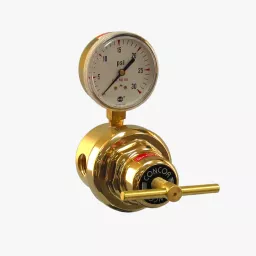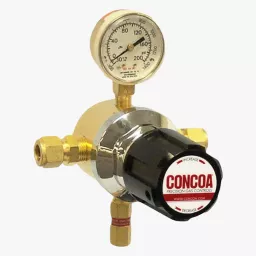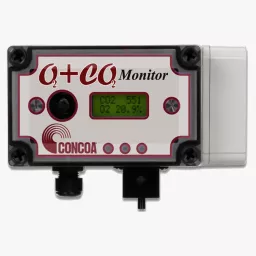Heat treatment processes include annealing, hardening, tempering, normalizing, aging, carburizing, and stress relieving. The atmosphere within a furnace chamber is the key to achieving successful, high-precision, repeatable results while preventing oxidation and other undesirable chemical reactions during each process.
The controlled atmospheres used in heat treatment have one of two common purposes: to be chemically inert (or protective) or chemically active (or reactive). An inert, or protective, atmosphere shields the product from unwanted chemical reactions like oxidation and decarburization. Conversely, desirable physical properties can be achieved, such as hardening, by promoting chemical reactions in a reactive atmosphere. In addition to air, gases commonly used to create a controlled furnace atmosphere include hydrogen, nitrogen, oxygen, helium, argon, and carbon dioxide. The first step to establishing an atmosphere is to purge the existing atmosphere from the furnace using the desired gas. For the introduction and removal of gases, the CONCOA 603 Series regulator provides the high-flow purging and process control required to support a controlled furnace atmosphere successfully.
Many controlled-atmosphere furnaces use a flame curtain at the door to contain the atmosphere. When the door is opened, the flame curtain burner activates and covers the door opening with a sheet of flame. This reduces oxygen inrush and maintains internal temperature, while also burning off any combustible gas that may escape while the furnace door is open. Typically, a simple line burner connected to a supply line of compressed air and a relatively high pressure of natural gas or propane (usually 2 PSIG or more) is used. The CONCOA 6790 Series pipeline regulator provides steady and reliable pressure and ensures efficient gas flow control needed to deliver the right air-gas ratio for a flame curtain in a controlled atmosphere furnace.
Safety is a chief concern when working with flammable gases required for heat treatment-related processes. Additionally, gas detection equipment should be employed when using large flows of inert gases. To minimize hazards, CONCOA suggests integrating gas detection and automated safety device equipment. CONCOA oxygen deficiency monitors or dual oxygen/carbon dioxide monitors, installed in gas storage and use areas, provide continuous detection and alert if high concentrations of oxygen-depleting gases should threaten respiration. The 580 Series flammable gas detector provides continuous monitoring of combustible gases and notification before an emergency. Integration with the CONCOA 585 Series emergency shut-off controller ensures the automatic shutdown of up to eight independent gas sources for maximum facility safety.
The 585 Series Emergency Shut-Off Controller is designed to automatically shut down up to eight independent flammable, toxic, corrosive, or high purity gas sources based on inputs from up to six gas monitoring devices. The CONCOA emergency shut-off controller incorporates an emergency stop button, audible and visual alarm, and onboard web server with email and real-time display for remote gas monitoring and program status. It is field configurable and easy to reset to meet the changing needs of laboratory systems that constantly reconfigure. Ideal for flammable or toxic gas shutdown control in the event of a fire or leak detection, the emergency shut-off controller is designed for broad integration into a comprehensive facility safety program.
The flammable gases used to create controlled furnace atmospheres make Therefore, any person working in the heat treatment industry should be aware of the hazards from processes and equipment and apply appropriate safeguards to control the risk at an acceptable level. CONCOA provides gas delivery solutions to achieve optimum results for the various processes involved in heat treatment applications. From innovative Switchovers and specialized regulators that can accommodate high and low-pressure gas sources to emergency shut off controllers that can be activated as a safeguard as soon as the hydrogen content of a mixture exceeds a predetermined set point. In addition to our standard product range, CONCOA supplies individual solutions to meet your precise gas compositions with repeatable accuracy.






